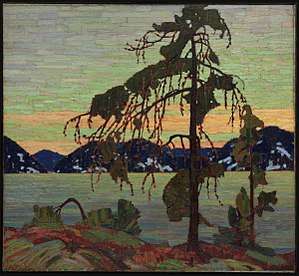William Cruikshank (painter)
William Cruikshank (1848/9 – 1922)[note 1] was a British painter and the grand-nephew of George Cruikshank. He studied art at the Royal Scottish Academy in Edinburgh, at the Royal Academy in London, and in Paris. His last studies were interrupted by the Franco-Prussian War.
William Cruikshank | |
|---|---|
| Born | 1848/9 |
| Died | 1922 (aged 72 or 73) |
| Nationality | Scottish and Canadian |
| Alma mater | |
| Known for | Painting |
| Elected | Royal Canadian Academy of Arts |
Career
In 1871, Cruikshank settled in Canada, opened a studio in Toronto and for twenty-five years was an instructor in the Central Ontario School of Art, later the Ontario College of Art, teaching how to draw from the antique (casts) and from life.[4][5] He claimed to have been responsible for bring the pen-and-ink technique of Europe to North America.[2] As a major member of the Toronto Art Students' League, he encourage his students to follow the motto Nulla Dies Sine Linea (No Day without a Line).[6] Eventual Group of Seven founder, J. E. H. MacDonald, would later say that the northern movement and search for a new Canadian art began with the work of Cruikshank and George Agnew Reid.[7]
In 1894 he was elected a member of the Royal Canadian Academy of Arts[8] and acquired a considerable reputation as a portrait and figure painter, and as a painter of Canadian scenes. Some of his paintings are in the National Gallery of Canada.
Tom Thomson
It has been suggested that around 1906 or 1907, Tom Thomson took private lessons from Cruikshank at the Ontario College of Art and Design.[9] Only two sources corroborate this however. The first is a single undated note from Cruikshank to professor James Mavor, arranging to bring a "Tomson" [sic] to meet him.[10] Further complicating the matter is that the original class list no longer survives.[11] The second is a letter from H. B. Jackson to Blodwen Davies, writing, "Tom studied from life & the antique in art school. If I remember right Cruikshank was the instructor."[12] Cruikshank was likely Thomson's only art instructor.[13]
Gallery
.jpg) Bullfinch, 1861–97. Boston Public Library
Bullfinch, 1861–97. Boston Public Library.jpg) Linnet, 1861–97. Boston Public Library
Linnet, 1861–97. Boston Public Library Breaking a Road, 1894. National Gallery of Canada, Ottawa
Breaking a Road, 1894. National Gallery of Canada, Ottawa Sand Wagon, 1895. National Gallery of Canada, Ottawa
Sand Wagon, 1895. National Gallery of Canada, Ottawa
References
Notes
- The National Gallery of Canada provides birth and death dates of 25 December 1848 and 19 May 1922, respectively.[1] Robert Stacey and Dennis Reid instead simply provide the years 1849 and 1922.[2][3] The National Gallery of Canada further provides his birthplace as Broughty Ferry and his death place as Kansas City, Missouri.[1]
Citations
- "William Cruikshank". www.gallery.ca. National Gallery of Canada. Retrieved 4 October 2018.
- Stacey (2002), p. 52.
- Reid (2002), p. 70.
- Murray (1986), p. 6.
- Reid (2002), p. 69–70.
- Stacey (2002), pp. 52–53.
- MacDonald (1926), quoted in Reid (2002), p. 74.
- "Members since 1880". Royal Canadian Academy of Arts. Archived from the original on 26 May 2011. Retrieved 11 September 2013.
-
- Hill (2002), p. 113
- Murray (1986), p. 6
- Murray (2002), p. 309
- Reid (2002), p. 69–70
- Silcox & Town (2017), p. 43
- Stacey (2002), p. 52
- Cruikshank, quoted in Reid (2002), p. 70n21.
- Reid (2002), p. 70n21.
- Jackson (1931), quoted in Hill (2002), p. 113n18.
- Silcox (2015), p. 9.
Literature
- Cruikshank, William. "to Prof. Mavor, no year" (14 February) [Letter]. Thomas Fisher Rare Book Library, Series: James Mavor Papers, Box: 4a. Toronto: University of Toronto.
- Hill, Charles (2002). "Tom Thomson, Painter". In Reid, Dennis (ed.). Tom Thomson. Toronto/Ottawa: Art Gallery of Ontario/National Gallery of Canada. pp. 111–43. ISBN 978-1-55365-493-3.CS1 maint: ref=harv (link)
- Jackson, H. B. "H. B. Jackson to Blodwen Davies" (29 April 1931) [Letter]. Blodwen Davies collection, Fonds: Blodwen Davies fond, Box: 11, ID: MG30-D38. Ottawa: Library and Archives Canada.
- MacDonald, J. E. H. (20 December 1926). "Unmailed". Letter to Fred Housser.CS1 maint: ref=harv (link)
- Mavor, James (1926). "William Cruikshank". Canadian Magazine.CS1 maint: ref=harv (link)
- Murray, Joan (1986). The Best of Tom Thomson. Edmonton: Hurtig. ISBN 978-0-88830-299-1.CS1 maint: ref=harv (link)
- ——— (2002). "Chronology". In Reid, Dennis (ed.). Tom Thomson. Toronto/Ottawa: Art Gallery of Ontario/National Gallery of Canada. pp. 307–317. ISBN 978-1-55365-493-3.CS1 maint: ref=harv (link)
- Reid, Dennis (2002). "Tom Thomson and the Arts and Crafts Movement in Toronto". In Reid, Dennis (ed.). Tom Thomson. Toronto/Ottawa: Art Gallery of Ontario/National Gallery of Canada. pp. 65–83.CS1 maint: ref=harv (link)
- Silcox, David P. (2015). Tom Thomson: Life and Work. Toronto: Art Canada Institute. ISBN 978-1-48710-075-9.CS1 maint: ref=harv (link)
- Silcox, David P.; Town, Harold (2017). The Silence and the Storm (Revised, Expanded ed.). Toronto: McClelland and Stewart. ISBN 978-1-44344-234-3.CS1 maint: ref=harv (link)
- Stacey, Robert (2002). "Tom Thomson as Applied Artist". In Reid, Dennis; Hill, Charles C. (eds.). Tom Thomson. Toronto/Ottawa: Art Gallery of Ontario/National Gallery of Canada. pp. 47–63.CS1 maint: ref=harv (link)
- Wallace, W. Stewart, ed. (1948). The Encyclopedia of Canada. 2. Toronto: University Associates of Canada.CS1 maint: ref=harv (link)
